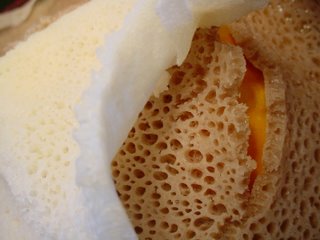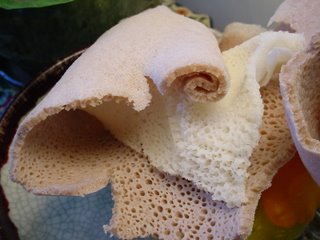 This is a platefull of torn Injera, Ethiopian bread I brought home from the Kokeb Restaurant in Seattle. We chose the restaurant because we wanted to try something different.
This is a platefull of torn Injera, Ethiopian bread I brought home from the Kokeb Restaurant in Seattle. We chose the restaurant because we wanted to try something different.Injera is made from a high-protein grain called tef. Tef grains are extremely small and grow only in Ethiopia. They've been used for the flat-cake breads for almost 4,000 years, with the recipe and preparations pretty much the same - fried, like a pancake. (Tef seeds were discovered in a pyramid thought to date back to 3359 BC.)
 Injera prepar- ation usually takes two to three days. The teff is milled into powder then mixed with water and yeast. (In these photos, brown rice flour is used for one of the breads.) The tef mixture is set aside at room temperature for 2 days so it ferments and raises. During the second day it starts to give tangy aromas as the fermentation releases air bubbles; this is where the Injera's slight tangy taste comes from.
Injera prepar- ation usually takes two to three days. The teff is milled into powder then mixed with water and yeast. (In these photos, brown rice flour is used for one of the breads.) The tef mixture is set aside at room temperature for 2 days so it ferments and raises. During the second day it starts to give tangy aromas as the fermentation releases air bubbles; this is where the Injera's slight tangy taste comes from. After the fermentation process is completed, the mixture is poured on a hot, flat-iron pan in a circular motion to achieve a thin consistency. When the hot pan and the fermented teff make contact, hundreds of tiny air bubbles escape, creating the pockmarked look of Injera. The side touching the hot pan gets a smooth look, while the one facing upwards has the holes. This proves to be quite utilitarian, when it is time to scoop up sauces and gravies.
 When we first sat down in the Kokeb Restau- rant, we were served a bowl of lentil soup as an appetizer, and it came with a spoon. But, that was the last utensil we used! When the soup bowls were taken away, the server brought hot washcloths and the injera, rolled up on a little platter. This injera served as our utensil to scoop up the sauces, meat, vegetables, and cheese. A flat injera pancake served as the plate for our food, with the entrees placed on top of it, much as Hawaiians would use a banana leaf for a plate.
When we first sat down in the Kokeb Restau- rant, we were served a bowl of lentil soup as an appetizer, and it came with a spoon. But, that was the last utensil we used! When the soup bowls were taken away, the server brought hot washcloths and the injera, rolled up on a little platter. This injera served as our utensil to scoop up the sauces, meat, vegetables, and cheese. A flat injera pancake served as the plate for our food, with the entrees placed on top of it, much as Hawaiians would use a banana leaf for a plate.George ordered a combination of all vegetable dishes, including all the side dishes, called Atkilt Beyayenetu. Red split lentils, cabage, carrots, onions, potatoes, collards, and tomatoes were served with tofu stew and split peas.
I ordered Asa Beyayenetu, which is a combination of all dishes including the seafoods - one type of prawn stew seasoned with a hearty sauce, and salmon marinated in a spicy sauce sauteed with peppers, onions and herbs. The cuisine of Ethiopia is based on an exotic blend of spices, both robust and subtle, like red chili, used in hot stews (Berbere); red chili powder mixed with spices (Mitmita); hot paste (Awaze); green jalapeno (Sineg Kareya); and hot mustard (Sena - fitch) ;and garlic, ginger and cardamon.
When we were finished with our meal, George said he understood why most Ethiopians were very slender - there was very little fat or salt in any of the dishes, and the extremely nourishing flatbread provided much of the bulk of the meal. It was 'light', perfect for a hot climate, and unlike anything we see in our southern states. I couldn't help but wonder, if our diet included some of these foods, how our health would improve as a result.